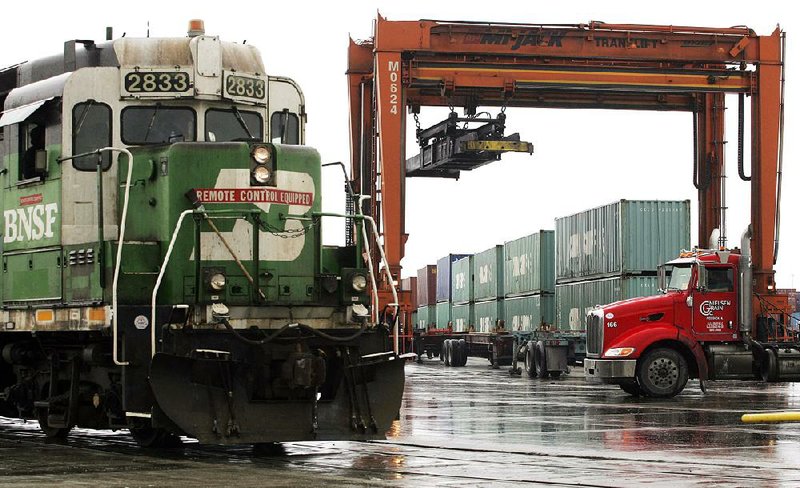J.B. Hunt Transport Services Inc. is urging the transportation industry to work together to solve congestion issues affecting capacity, service and growth at railroad terminals across North America.
The Lowell-based company's request was published in a recent white paper titled "Dwell: How Intermodal Terminal Congestion Impacts Capacity and Service." J.B. Hunt, which is regarded as one of the leaders in intermodal shipping, used the 10-page document to outline issues it believes are slowing growth and propose solutions in hopes of "significantly" reducing congestion and delays.
"Every additional minute a train is stuck at the rail yard unable to unload, money is lost," the company said in the white paper. "It is critical that railroads find a way to increase their terminal throughput before dwell pushes costs and congestion to insurmountable levels."
Dwell, which is the period of time between when an intermodal container is unloaded from a train and when it has departed from the rail facility, was highlighted by the company as an area to improve.
Intermodal shipping consists of two or more forms of freight movement, including rail, truck and boat. J.B. Hunt's intermodal segment began operations in 1989 when it formed a partnership with what is now BNSF Railway Company, according to the company's annual report.
Traffic on U.S railways has been rising over the past several years. In 2014, there was an increase of 1.2 million shipments, which included 665,630 intermodal containers according to the white paper. But J.B. Hunt said inefficiencies in the intermodal network are becoming "more transparent and have a compounding negative impact for railroads, carriers and shippers."
J.B. Hunt deems 24 hours as an acceptable dwell time for a container to depart a rail yard after being unloaded. However, a company-conducted survey of three undisclosed railroads showed dwell time was, on average, more than 17 hours longer than the acceptable amount.
The white paper outlines a number of reasons for the wide gap: Receiving locations are not open or available for weekend or holiday deliveries, "dynamic" transit guides are unavailable, rail service variability and the insufficient storage space of receivers.
J.B. Hunt also offers solutions like asking shippers and receivers to accommodate night and weekend deliveries, adjusting shipment patterns and ensuring adequate space at receiving locations.
Katie Farmer, chairman of the Intermodal Association of North America and BNSF Group vice president for consumer products, agreed there are a variety of reasons dwell exists and certain changes can reduce the effect. She specifically pointed to the "weekend effect."
"We know current freight patterns indicate that dwell is greatest for units made available for pick up on Friday, Saturday and Sunday. By Monday morning, terminals are often exceeding maximum capacity," Farmer said in an email. "By smoothing freight flows between the days of the week, all parties in the supply chain can access additional capacity and receive more consistent service."
A J.B. Hunt spokesman said the company would have no further comment on the white paper. But J.B. Hunt's interest in reducing dwell is no surprise because of its importance for business.
J.B. Hunt's $949 million in intermodal revenue during the third quarter of 2015, which was down two percent from the previous year, represented about 60 percent of the business. The company's intermodal segment produced $3.7 billion of its $6.2 billion in revenue in 2014.
Intermodal growth has slowed the past year largely because of declining fuel prices and unreliability of rail shipments. But J.B. Hunt's 2016 expectations -- published earlier this week -- project an 8 percent to 10 percent intermodal load growth compared to 2015 levels, and Morningstar analyst Matt Young believes the company remains well positioned for the future.
"Intermodal has a lot of attractive tailwinds because you've got a tight driver market, which drives a tight capacity market in the trucking industry," Morningstar analyst Matt Young said recently. "Shippers are more and more including intermodal into their supply chains to ensure against capacity shortages and to make sure everything gets moved. So the longer term picture is there."
J.B. Hunt has support in its plea to reduce dwell with at least one of its rail partners as well.
BNSF Railway is working to crack down on dwell with revamped policies it introduced earlier this year to help improve circulation and prepare for an anticipated growth in traffic. The new guidelines include increased charges for container storage exceeding 24 or 48 hours, depending on the terminal. BNSF also eliminated Sunday as a free day at the terminals.
IANA also is working to address dwell issues at terminals through its committee task forces, too, according to Joni Casey, president and chief executive officer. Like J.B. Hunt, the IANA believes a concerted effort across the supply chain to "eliminate inefficiencies" will help generate "much needed additional capacity to support customer's growth over the next several years."
"Through engagement and increased awareness of the problem, dwell can be significantly reduced increasing valuable rail ramp capacity," J.B. Hunt said in the white paper.
Business on 11/13/2015

